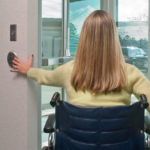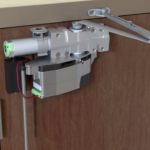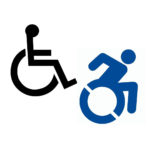 Low energy automatic operators are the type of automatic door operators that are typically actuated by a “knowing act.” These doors open slowly to allow for accessibility or convenience, in compliance with the ANSI/BHMA A156.19 standard. The requirements for these operators differ from power operated pedestrian doors, which are typically opened with a sensor and must comply with ANSI/BHMA A156.10.
Low energy automatic operators are the type of automatic door operators that are typically actuated by a “knowing act.” These doors open slowly to allow for accessibility or convenience, in compliance with the ANSI/BHMA A156.19 standard. The requirements for these operators differ from power operated pedestrian doors, which are typically opened with a sensor and must comply with ANSI/BHMA A156.10.
There are several questions about low-energy automatic operators that come up frequently:
What type of actuation is considered a “knowing act”?
A knowing act is defined by the A156.19 standard as: Any conscious action with the expected result of opening a door. This includes but is not limited to: wall or jamb-mounted contact or non-contact switches such as push plates; the action of manual opening (pushing or pulling) a door; and controlled access devices such as keypads, card readers, wireless transmitters and keyswitches.
Stepping into the detection field of a sensor is not considered a knowing act. If an automatic door with a low-energy operator is opened by a sensor, it must meet the requirements of A156.10, including safety sensors and guide rails, where required.
For additional information on automatic door actuation, visit these posts:
- Decoded: Actuators for Low-Energy Operators
- Touchless Actuators
- Push-N-Go for Automatic Operators
- WWYD? Auto Operator App
- Knowing Act Operation – What’s happening here?
Do doors with low-energy automatic operators require safety sensors?
For automatic doors with low-energy operators, safety sensors are typically required only when the door is opened by a sensor detecting a building occupant stepping into the detection field. If the low-energy operator is opened by a knowing act (see above), safety sensors are not mandated by the model codes or referenced standards. When a sensor is used to actuate the operator, the door must comply with the A156.10 standard, which requires safety sensors and in most cases guide rails. When sensors are required, a 2017 change to A156.10 requires the safety sensors to be monitored. If the sensors are not functioning to ensure the safety of building occupants, the door must not open automatically (more info here).
Under what circumstances do doors with automatic operators require stand-by power?
The accessibility standards require automatic (and manually operated) doors to have a certain amount of maneuvering clearance for egress; if an automatic door has stand-by power, the maneuvering clearance is not required. If the door does not have the required amount of maneuvering clearance on the egress side, adding stand-by power for the operator can help to solve the problem. There is additional information about this requirement in the Decoded article addressing this topic. Keep in mind that if the door is required to be a fire door assembly, the automatic operator must be deactivated if there is a fire, so stand-by power can not be used to address the maneuvering clearance issue on fire doors (the applicable paragraph from NFPA 80 is in this post).
Are there locations where automatic operators are required by the model codes or accessibility standards?
Prior to 2021, the codes and standards did not mandate auto operators, although they are sometimes installed to overcome a code issue such as limited maneuvering clearance, or opening force that exceeds the maximum allowed by code. A change was made to the 2021 edition of the International Building Code (IBC), mandating automatic operators on accessible public entrances in buildings of certain occupancy types and occupant loads. This Decoded article addresses the code change in depth.
Additional Resources
Here are some additional links for information on the requirements of the codes and standards related to low-energy automatic operators:
- Intro to Low-Energy Automatic Operators (video)
- Opening/Closing Speed, Hold-Open Time
- What is a power-assist operator?
- Manual Opening Force For Automatic Doors
- Decoded: Signage for Automatic Doors
- LCN Automatic Operators
Do you have an FAQ that you need answered? Leave it in the comment box!
You need to login or register to bookmark/favorite this content.









Lori when low energy operators are used with controlled access ,restricted to those that have access id a knowing act device required or is the access control reader all that is required for entry . I understand that the button is required for exit
Hi David –
The access control reader is considered a knowing act, so it meets the criteria for that requirement. With that said, there may be some situations where limiting automatic operator access to people who have an access control credential could be a problem. So that’s something to consider.
– Lori
I’m working on a new construction project with low energy operators and RIM devices on the schedule. My question is this: this. Will simply dogging the RIM devices during hours of operation be adequate? Should they have electrified panics or electric strikes to work in conjunction with the operators to avoid stress if left undogged or to latch for draft control?
Hi Steve –
I think it’s better to use electric latch retraction so the operators can be used to exit when the doors are locked (and latched) to prevent access.
– Lori